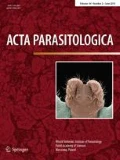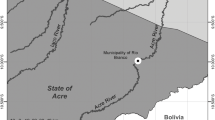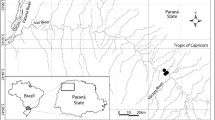Abstract
The aim of the present study was to detect the alterations of Pseudoplatystoma corruscans parasite infracommunity structure, after the construction of the Porto Primavera dam on the high Paraná River floodplain. The execution of this research was based on 119 host specimens collected between March 2011 and September 2012, and the results were compared to studies performed on periods before the reservoir’s construction, when 110 fishes were collected between March 1992 and February 1993. Five parasite species still remain on the environment, despite the environmental modifications: Choanoscolex abscissus, Spasskyelina spinulifera, Nomimoscolex pertierrae, Harriscolex kaparari and Contracaecum sp 2. The Berger-Parker dominance index, calculated to the parasite fauna of 1992, did not show the dominance of any species, while, on the present days, this same index accused the dominance of Nomimoscolex pertierrae (49%) and Choanoscolex abscissus (50%). The present study reports the disappearance of Megathylacus travassosi, Contracaecum sp. 1, Contracaecum sp. 3, Procamallanus (Spirocamallanus) sp. and Cucullanus pseudoplatystomae, suggesting the possibility of a local extinction or a host switch of these species. It has also been registered an Acanthocephala specimen, a genus not observed on this host yet. The results here presented show that the antropic influences on natural systems alter the environmental conditions, what is reflected on the richness and diversity parasite levels.
Similar content being viewed by others
References
Agostinho A.A., Bini L.M., Gomes L.C., Júlio-Jr H.F., Pavanelli C.S., Agostinho C.S. 2004. Fish assemblages. In: (Eds. S.M. Thomaz, A.A. Agostinho and N.S. Hahn) The Upper Paraná River and its floodplain: physical aspects, ecology and conservation. Backhuys Publishers, Leiden, 223–246.
Agostinho A.A., Pelicice F.M., Gomes L.C. 2008. Dams and the fish fauna of the Neotropical region: impacts and management related to diversity and fisheries. Brazilian Journal of Biology, 68(4), 1119–1132. DOI: 1590/S1519-69842008000500019.
Barbosa F.A.R., Padisák J., Espíndola E.L.G., Borics G., Rocha O. 1999. The cascading reservoir continuum concept (CRCC) and its application to the river Tietê-basin, São Paulo State, Brazil. In: (Eds. J.G. Tundisi and M. Straskraba) Theoretical reservoir ecology and its applications. Leiden, Backhuys Publishers, 425–437.
Bonecker C.C., Aoyagui A.S.M., Santos R.M. 2009. The impact of impoundment on the rotifer communities in two tropical floodplain environments: interannual pulse variations. Brazilian Journal of Biology, 69, 529–537. DOI: 1590/S1519-69842009000300008.
Boukal D.S., Jankoysky M., Kubecka J., Heino M. 2012. Stock-catch analysis of carp recreational fisheries in Czech reservoirs: Insights into fish survival, water body productivity and impact of extreme events. Fisheries Research, 119, 23–32. DOI: 1016/j.fishres.2011.12.003.
Brooks D.R., Ferrao A.L. 2005. The historical biogeography of coevolution: emerging infectious diseases are evolutionary accidents waiting to happen. Journal of Biogeography, 32, 1291–1299. DOI: 10.1111/j.1365-2699.2005.01315.x.
Bunn S.E., Arthington A.H. 2002. Basic principles and ecological consequences of altered flow regimes for aquatic biodiversity. Environmental Management, 30, 492–507. DOI: 10.1007/s00267-002-2737-0.
Bush A.O., Lafferty K.D., Lotz J.M., Shostak A.W. 1997. Parasitology meets ecology on its own terms: Margolis et al. revisited. Journal of Parasitology, 83, 575–583. DOI:10.2307/3284227.
Chambrier A., Takemoto R.M., Pavanelli G.C. 2006. Nomimoscolex pertierrae n. sp. (Eucestoda: Proteocephalidea), a parasite of Pseudoplatystoma corruscans (Siluriformes: Pimelodidae) in Brazil and redescription of N. sudobim Woodland, 1935, a parasite of P. fasciatum. Systematic Parasitology, 64, 191–202. DOI: 10.1007/s11230-006-9031-0.
Degu A.M., Hossain F. 2012. Investigating the mesoscale impact of artificial reservoirs on frequency of rain during growing season. Water Resources Research, 48, 1–15. DOI: 1029/2011WR010966.
Eiras J.C., Takemoto R.M., Pavanelli G.C. 2006. Métodos de Estudo e Técnicas Laboratoriais em Parasitologia de Peixes. 2nd ed. Maringá, EDUEM, 199 pp.
FUEM-NUPELIA/PADCT/CIAMB (1994) Estudos ambientais da planície de inundação do rio Paraná no trecho compreendido entre a foz do rio Paranapanema e o reservatório de Itaipu: relatório anual do projeto de pesquisa. Projeto de Pesquisa Convênio PADCT/CIAMB. Maringá, vol. 3.
Gomes L.C., Bulla C.K., Agostinho A.A., Vasconcelos L.P., Miranda L.E. 2012. Fish assemblage dynamics in a Neotropical floodplain relative to aquatic macrophytes and the homogenizing effect of a flood pulse. Hydrobiology, 685, 97–107. DOI: 10.1007/s10750-011-0870-6.
Hatcher M.J., Dick J.T., Dunn A.M. 2012. Diverse effects of parasites in ecosystems: linking interdependent processes. Frontiers in Ecology and Environment, 10, 186–19. DOI: 1890/110016.
Holmes J.C. 1979. Parasite populations and host community structure. In: (Ed. B.B. Nickol) Host-parasite interfaces. Academic Press, New York, 27–46.
Holmes J.C. 1983. Evolutionary relationships between parasitic helminths and their hosts. In: (Eds. D.J. Futuyma and M. Slatkin) Coevolution, Sinauer Associates Inc., Sunderland, Massachusetts, 161–185.
Hudson P.J., Dobson A.P., Lafferty K.D. 2006. Is a healthy ecosystem one that is rich in parasites? Trends in Ecology and Evolution, 21, 381–385. DOI: 1016/j.tree.2006.04.007.
Junk W.J., Bayley P.B., Sparks R.E. 1989. The flood pulse concept in river-floodplain systems. Canadian Special Publications in Fisheries and Aquatic Sciences, 106, 110–127. DOI: 1029/2000JD000306.
Karling L.C., Isaac A., Affonso I.P., Takemoto R.M., Pavanelli G.C. 2012. The impact of a dam on the helminth fauna and health of a neotropical fish species Salminus brasiliensis (Cuvier 1816) from the upper Paraná River. Journal of Helminthology, 87, 245–251. DOI: 10.1017/S0022149X1200034X.
Khalil L.F., Jones A., Bray R.A. (Eds.). 1994. Keys to the cestode parasites of vertebrates. CAB International, Wallingford, Oxon, 768p.
Lafferty K.D. 1997. Environmental parasitology: what can parasites tell us about human impacts on the environment? Parasitology Today, 13, 251–255. DOI: 10.1016/S0169-4758(97)01072-7.
Landsberg J.H., Blakesley B.A., Reese R.O., McRae G., Forstchen P.R. 1998. Parasites of fish as indicators of environmental stress. Environmental Monitoring and Assessment, 51, 211–232. DOI: 1023/A:1005991420265.
Le-Cren E.D. 1951. The length-weight relationship and seasonal cycle in gonad weight and conditions in the perch Perca fluviatilis. Journal of Animal Ecology, 20, 201–211. DOI: 10.2307/1540.
Lizama M.A.P., Takemoto R.M., Ranzani-Paiva M.J.T., Ayroza L.M.S., Pavanelli G.C. 2007. Relação parasito-hospedeiro em peixes de pisciculturas da região de Assis, Estado de São Paulo, Brasil. Oreochromis niloticus (Linnaeus, 1757). Acta Scientiarium: Biological Sciences, 29, 223–231. DOI: 10.4025/actascibiolsci.v29i2.594.
Machado M.H., Pavanelli G.C., Takemoto R.M. 1994. Influence of hosts sex and size on endoparasitic infrapopulations of Pseudoplatystoma corruscans and Schizodon borelli (Osteichthyes) of the high River Paraná. Revista Brasileira de Parasitologia Veterinária, 3, 143–148.
Machado M.H., Pavanelli G.C., Takemoto R.M. 1995. Influence of the type of environment and of the hydrological level variation in endoparasitic infrapopulations of Pseudoplatystoma corruscans and Schizodon borelli (Osteichthyes) of the high Paraná River, Brazil. Revista Brasileira de Zoologia, 12, 961–976. DOI: 1590/S0101-81751995000400023.
Machado M.H., Pavanelli G.C., Takemoto R.M. 1996. Structure and diversity of endoparasitic infracommunities and the trophic level of Pseudoplatystoma corruscans and Schizodon borelli (Osteichthyes) of the high Paraná River. Memórias do Instituto Oswaldo Cruz, 91, 441–448. DOI: 1590/S0074-02761996000400010.
Mateus L.A.F., Petrere-Jr M. 2004. Age, growth and yield per recruit analysis of the pintado Pseudoplatystoma corruscans (Agassiz, 1829) in the Cuiabá River basin, Pantanal Matogrossense, Brazil. Brazilian Journal of Biology, 64, 257–264. DOI: 1590/S1519-69842004000200011.
Moore J., Lasswell J. 1986. Altered behavior in isopods (Armadillidium vulgare) infected with the nematode (Dispharynx nasuta). Journal of Parasitology, 72, 186–189. DOI: 2307/3281818.
Moravec F. (Ed.). 1998. Nematodes of Freshwater Fishes of the Neotropical Region. Academia, Praha, 464 pp.
Neiff J.J. 2001. Diversity in some tropical wetlands systems of South America. In: (Eds. B. Gopal, W.J Junk and J.A. Davis). Biodiversity in Wetlands: assessment, function and conservation. Backhuys, Leiden, 157–186.
Poulin R., Morand S. (Eds.). 2004. Parasite Biodiversity. Smithsonian Books, Washington, 216 pp.
Roberto M.C.A., Santana N.F.B., Thomaz S.M. 2009. Limnology in the Upper Paraná River floodplain: large-scale spatial and temporal patterns, and the influence of reservoirs. Brazilian Journal of Biology, 69, 717–725. DOI: 1590/S1519-69842009000300025.
Rocha P.C., Sant’Anna-Neto J.L. 2010. Ritmo climático e dinamica limnológica na planície fluvial do alto rio Paraná, centro-sul do Brasil. Revista Brasileira de Climatologia, 6, 169–188.
Rooney N., McCann K.S. 2012. Integrating food web diversity, structure and stability. Trends in Ecology and Evolution, 27, 40–46. DOI: 1016/j.tree.2011.09.001.
Rosin G.C.A., Oliveira-Mangarotti D.P.A., Takeda A.M.B., Butakka C.M.M.A. 2009. Consequences of dam construction upstream of the Upper Paraná River floodplain (Brazil): a temporal analysis of the Chironomidae community over an eight-year period. Brazilian Journal of Biology, 69, 591–608. DOI: 1590/S1519-69842009000300014.
Schulte R.D., Makus C., Hasert B., Michiels N.K., Schulenburg H. 2011. Host parasite local adaptation after experimental coevolution experimental coevolution of Caenorhabditis elegans and its microparasite Bacillus thuringiensis. Proceedings of the Royal Society — Biological Sciences, 278, 2832–2839. DOI: 1098/rspb.2011.0019.
Souza-Filho E.E., Stevaux J.C. 2004. Geology and geomorphology of the Baía-Curutuba-Ivinheima river complex. In: (Eds. S.M. Thomaz, A.A. Agostinho and N.S. Hahn) The Upper Paraná River and its floodplain: physical aspects, ecology and conservation. Leiden, Backhuys, 1–29.
Thomaz S.M., Bini L.M., Bozelli R.L. 2007. Floods increase similarity among aquatic habitats in river-floodplain systems. Hydrobiologia, 579, 1–13. DOI: 10.1007/s10750-006-0285-y.
Thompson J.N. (Ed.). 2005. The geographic mosaic of coevolution. University of Chicago Press, Chicago, IL, 400 pp.
Vidal-Martinez V.M., Pech D., Sures B., Purucker S.T., Poulin R. 2009. Can parasites really reveal environmental impact? Trends in Parasitology, 26, 44–51. DOI: 1016/j.pt.2009.11.001.
Ward J.V., Stanford J.A. 1995. Ecological connectivity in alluvial river ecosystems and its disruption by flow regulation. Regulated Rivers: Research & Management, 11, 105–119. DOI: 10.1002/rrr.3450110109.
Zar J.H. (Ed.). 1999. Biostatistical Analysis. 4th ed. Prentice-Hall, New Jersey, 663 pp.
Zurbrugg R., Suter S., Lehmann M.F., Wehrli B., Senn D.B. 2013. Organic carbon and nitrogen export from a tropical dam-impacted floodplain system. Biogeography, 10, 23–38. DOI: 5194/bg-10-23-2013.
Author information
Authors and Affiliations
Corresponding author
Rights and permissions
About this article
Cite this article
Ribeiro, T.S., Lizama, M.A.P. & Takemoto, R.M. Metazoan endoparasites diversity of Pseudoplatystoma corruscans (Siluriformes: Pimelodidae) as an indicator of environmental alterations on a tropical aquatic system. Acta Parasit. 59, 398–404 (2014). https://doi.org/10.2478/s11686-014-0260-0
Received:
Revised:
Accepted:
Published:
Issue Date:
DOI: https://doi.org/10.2478/s11686-014-0260-0




